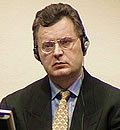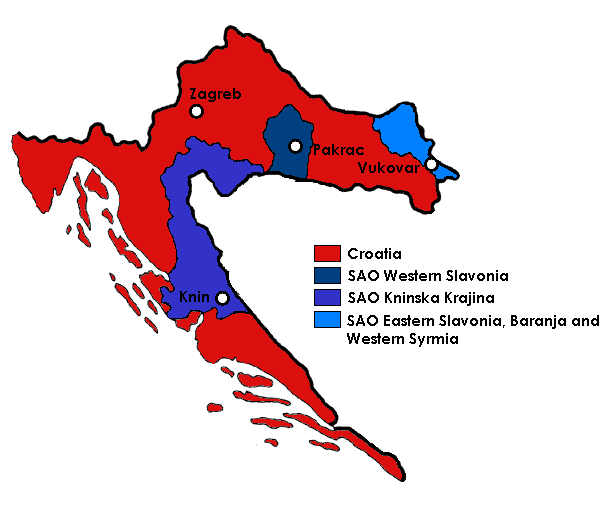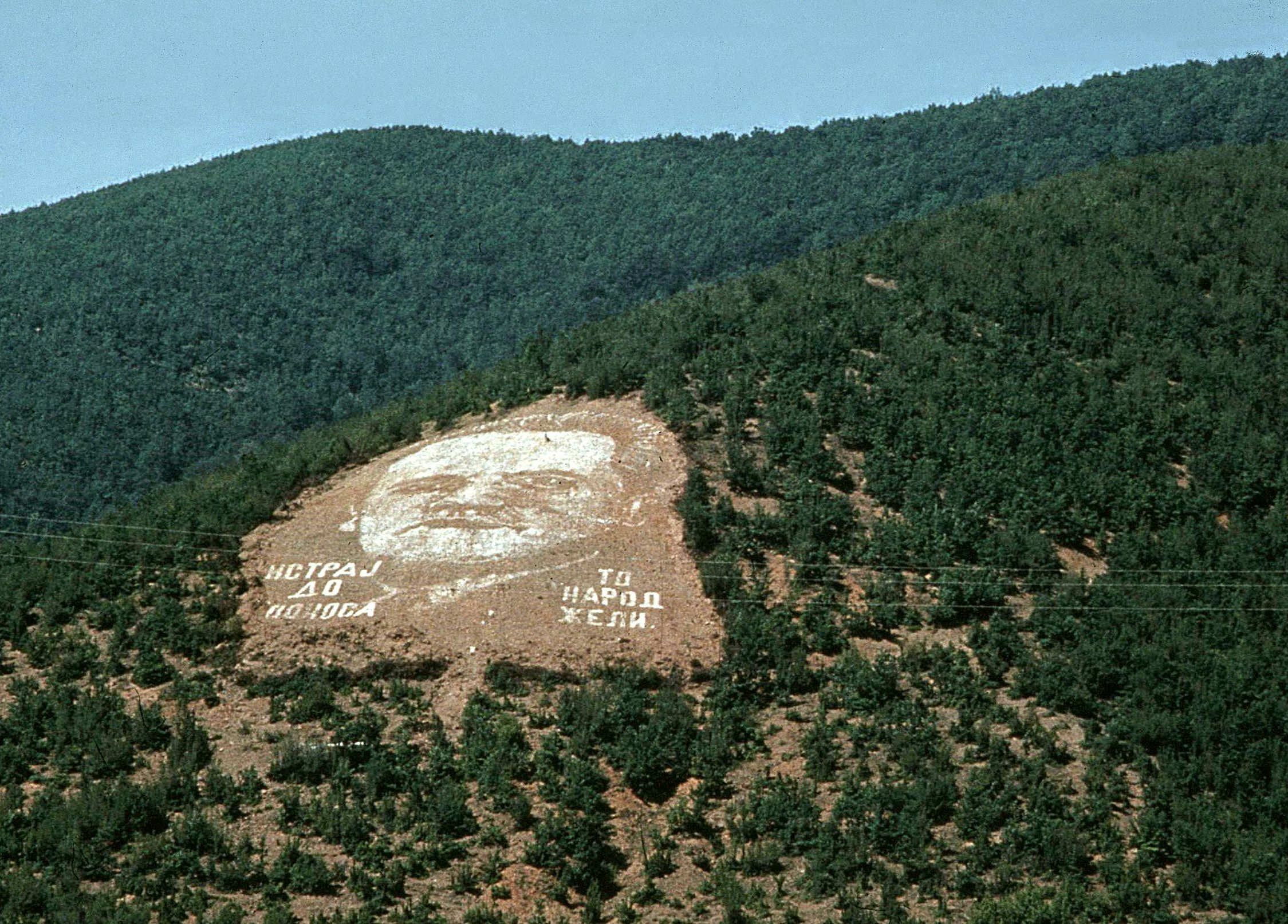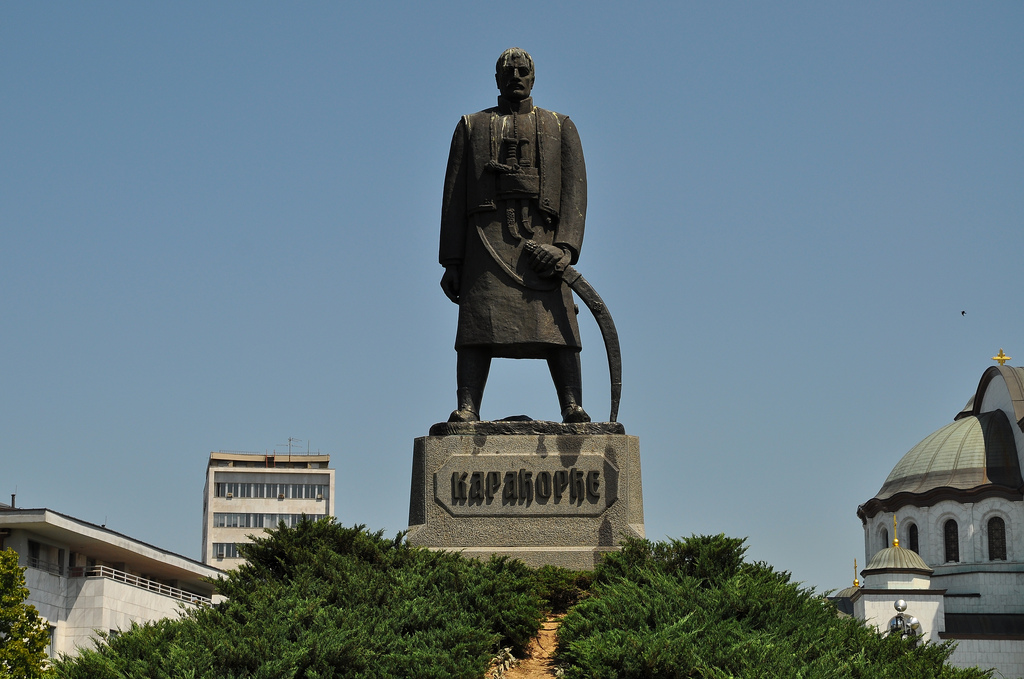|
Milan Babić
Milan Babić ( sr-Cyrl, Милан Бабић; 25 February 1956 – 5 March 2006) was a Croatian Serb politician and war criminal who served as the first president of the Republic of Serbian Krajina, a self-proclaimed state largely populated by Serbs of Croatia that wished to break away from Croatia during the Croatian War of Independence. After the war, he was indicted for war crimes by the International Criminal Tribunal for the Former Yugoslavia (ICTY) in 2004 and was the first ever indictee to plead guilty and enter a plea bargain with the prosecution, after which he was sentenced to 13 years in prison. Babić expressed "shame and remorse" in a public statement and declared that his plea bargain was intended to relieve the collective shame of the Croatian Serbs, and asked his "Croatian brothers to forgive their Serb brothers" for their actions. After he was sentenced in 2004, Babić was found dead in his prison cell in The Hague in March 2006, in an apparent suicide. E ... [...More Info...] [...Related Items...] OR: [Wikipedia] [Google] [Baidu] |
List Of Presidents Of The Republic Of Serbian Krajina
The Republic of Serbian Krajina or Serb Republic of Krajina ( sh, Република Српска Крајина, italics=no / or РСК / ''RSK'', ), known as the Serbian Krajina ( / ) or simply Krajina, was a self-proclaimed Serb proto-state, a territory within the newly independent Republic of Croatia (formerly part of Socialist Yugoslavia), which it defied, and which was active during the Croatian War of Independence (1991–95). It was not recognized internationally. The name ''Krajina'' ("Frontier") was adopted from the historical Military Frontier of the Habsburg monarchy (Austria-Hungary), which had a substantial Serb population and existed up to the late 19th century. The RSK government waged a war for ethnic Serb independence from Croatia and unification with the Federal Republic of Yugoslavia and Republika Srpska (in Bosnia and Herzegovina)."DOKUMENTI INSTITUCIJA POBUNJENIH SRBA U REPUBLICI HRVATSKOJ (siječanj – lipanj 1993.)", edicija "REPUBLIKA HRVATSKA I DOMOVINSK ... [...More Info...] [...Related Items...] OR: [Wikipedia] [Google] [Baidu] |
Vrlika
Vrlika is a small town in inland Split-Dalmatia County, Croatia. The closest large towns are Sinj, Knin, and Drniš. Vrlika was given the status of town in 1997. Vrlika is an underdeveloped municipality which is statistically classified as the First Category Area of Special State Concern by the Government of Croatia. Location Vrlika is located in the Cetinska Krajina region in Split-Dalmatia County. It is 40 km northwest of the town of Sinj on the State route D1 between the towns of Sinj and Knin and on the regional route which connects Vrlika with Drniš. History The oldest evidence for human life in this region is from 30,000 BC. During the Bronze Age, between 1900-1600 BC, there was the so-called Cetina culture on the territory of Vrlika municipality. Archaeologists have found ancient graves, a Bronze Age sword and other smaller items dating back to that period. These findings made it clear that in the past this land was densely populated. Prior to the arrival of the ... [...More Info...] [...Related Items...] OR: [Wikipedia] [Google] [Baidu] |
Vojislav Šešelj
Vojislav Šešelj ( sr-Cyrl, Војислав Шешељ, ; born 11 October 1954) is a Serbian politician, founder and president of the far-right Serbian Radical Party (SRS); he was convicted of war crimes by the International Criminal Tribunal for the former Yugoslavia (ICTY). Between 1998 and 2000, he served as the deputy prime minister of Serbia. He voluntarily surrendered to the ICTY in February 2003 but his trial did not begin until November 2007. Šešelj's trial was marred with controversy: he went on hunger strike for nearly a month until finally being allowed to represent himself, regularly insulted the judges and court prosecutors once proceedings commenced, disclosed the identities of protected witnesses and was penalized on three occasions for disrespecting the court. He did not call any witnesses in his defense. After spending 11 years and 9 months in detention in the United Nations Detention Unit of Scheveningen during his trial, Šešelj was permitted to tempor ... [...More Info...] [...Related Items...] OR: [Wikipedia] [Google] [Baidu] |
Dalmatia
Dalmatia (; hr, Dalmacija ; it, Dalmazia; see #Name, names in other languages) is one of the four historical region, historical regions of Croatia, alongside Croatia proper, Slavonia, and Istria. Dalmatia is a narrow belt of the east shore of the Adriatic Sea, stretching from the island of Rab in the north to the Bay of Kotor in the south. The Dalmatian Hinterland ranges in width from fifty kilometres in the north, to just a few kilometres in the south; it is mostly covered by the rugged Dinaric Alps. List of islands of Croatia, Seventy-nine islands (and about 500 islets) run parallel to the coast, the largest (in Dalmatia) being Brač, Pag (island), Pag, and Hvar. The largest city is Split, Croatia, Split, followed by Zadar and Šibenik. The name of the region stems from an Illyrians, Illyrian tribe called the Dalmatae, who lived in the area in classical antiquity. Later it became a Dalmatia (Roman province), Roman province, and as result a Romance languages, Romance culture ... [...More Info...] [...Related Items...] OR: [Wikipedia] [Google] [Baidu] |
Militia
A militia () is generally an army or some other fighting organization of non-professional soldiers, citizens of a country, or subjects of a state, who may perform military service during a time of need, as opposed to a professional force of regular, full-time military personnel; or, historically, to members of a warrior-nobility class (e.g. knights or samurai). Generally unable to hold ground against regular forces, militias commonly support regular troops by skirmishing, holding fortifications, or conducting irregular warfare, instead of undertaking offensive campaigns by themselves. Local civilian laws often limit militias to serve only in their home region, and to serve only for a limited time; this further reduces their use in long military campaigns. Beginning in the late 20th century, some militias (in particular officially recognized and sanctioned militias of a government) act as professional forces, while still being "part-time" or "on-call" organizations. For instan ... [...More Info...] [...Related Items...] OR: [Wikipedia] [Google] [Baidu] |
SAO Krajina
The Serbian Autonomous Oblast of Krajina ( sh-Latn-Cyrl, separator=" / ", Srpska autonomna oblast Krajina, Српска аутономна област Крајина) or SAO Krajina () was a self-proclaimed Serbian autonomous region (oblast) within modern-day Croatia (then a part of Yugoslavia). The territory consisted of majority-Serbian municipalities of the Republic of Croatia that declared autonomy in October 1990. It was formed as the SAO Kninska Krajina (САО Книнска Крајина), but, upon inclusion of additional Serb-populated areas, changed its name simply to SAO Krajina. In 1991 the SAO Krajina declared itself the Republic of Serbian Krajina, and subsequently included the other two Serbian SAOs in Croatia, the SAO Western Slavonia and the SAO Eastern Slavonia, Baranja and Western Syrmia. History After the Croatian multi-party elections in 1990, ethnic tensions within Croatia increased. The Croatian President Franjo Tuđman was planning Croatian secess ... [...More Info...] [...Related Items...] OR: [Wikipedia] [Google] [Baidu] |
Serb Autonomous Regions
From August 1990 to November 1991, during the breakup of Yugoslavia, several Serb Autonomous Regions, or Districts ( sr, Српска аутономна област (САО) / ) were proclaimed in the Yugoslav republics of SR Croatia and SR Bosnia and Herzegovina in light of the possible secession of the republics from the Socialist Federal Republic of Yugoslavia. These were autonomous Serb-inhabited entities that subsequently united in their respective republic to form the Republic of Serbian Krajina in Croatia and the Republika Srpska in Bosnia and Herzegovina. SAOs in Croatia * SAO Kninska Krajina (later SAO Krajina) * SAO Eastern Slavonia, Baranja and Western Syrmia (later Eastern Slavonia, Baranja and Western Syrmia) * SAO Western Slavonia SAOs in Bosnia and Herzegovina The Serb Democratic Party established SAOs in Serb-inhabited territories. Between September–November 1991, six entities had been proclaimed. The Serbs set up their own parliament, having left the Bos ... [...More Info...] [...Related Items...] OR: [Wikipedia] [Google] [Baidu] |
Slobodan Milošević
Slobodan Milošević (, ; 20 August 1941 – 11 March 2006) was a Yugoslav and Serbian politician who was the president of Serbia within Yugoslavia from 1989 to 1997 (originally the Socialist Republic of Serbia, a constituent republic of the Socialist Federal Republic of Yugoslavia, from 1989 to 1992) and president of the Federal Republic of Yugoslavia from 1997 to 2000. Formerly a high-ranking member of the League of Communists of Serbia (SKS) during the 1980s, he led the Socialist Party of Serbia from its foundation in 1990 until 2003. Born in Požarevac, he studied law at the University of Belgrade Faculty of Law and joined the League of Socialist Youth of Yugoslavia as a student. During the 1960s he served as an advisor to mayor of Belgrade Branko Pešić, and was later appointed chairman of Tehnogas and Beobanka, roles which he served until the 1980s. Milošević rose to power in 1987 by promoting populist and nationalist views, arguing for the reduction of power of S ... [...More Info...] [...Related Items...] OR: [Wikipedia] [Google] [Baidu] |
SR Serbia
, life_span = 1944–1992 , status = Constituent state of Yugoslavia , p1 = Territory of the Military Commander in Serbia , flag_p1 = Flag of German Reich (1935–1945).svg , p2 = Kingdom of Hungary (1920–1946)Kingdom of Hungary , flag_p2 = Flag of Hungary (1920–1946).svg , p3 = Independent State of Croatia , flag_p3 = Flag of Independent State of Croatia.svg , p4 = Kingdom of Bulgaria , flag_p4 = Flag of Bulgaria.svg , s1 = Republic of Serbia (1992–2006)Republic of Serbia , flag_s1 = Flag of Serbia (1992-2004).svg , image_flag = Flag of the Socialist Republic of Serbia.svg , flag_type = Flag(1947–1992) , image_coat = Coat of arms of Serbia (1947–2004).svg , symbol_type = Emblem(1947–1992) , common_language ... [...More Info...] [...Related Items...] OR: [Wikipedia] [Google] [Baidu] |
Yugoslav People's Army
The Yugoslav People's Army (abbreviated as JNA/; Macedonian and sr-Cyrl-Latn, Југословенска народна армија, Jugoslovenska narodna armija; Croatian and bs, Jugoslavenska narodna armija; sl, Jugoslovanska ljudska armada, JLA), also called the Yugoslav National Army, was the military of the Socialist Federal Republic of Yugoslavia and its antecedents from 1945 to 1992. Origins The origins of the JNA started during the Yugoslav Partisans of World War II. As a predecessor of the JNA, the People's Liberation Army of Yugoslavia (NOVJ) was formed as a part of the anti-fascist People's Liberation War of Yugoslavia in the Bosnian town of Rudo on 22 December 1941. After the Yugoslav Partisans liberated the country from the Axis Powers, that date was officially celebrated as the "Day of the Army" in the Socialist Federal Republic of Yugoslavia (SFR Yugoslavia). In March 1945, the NOVJ was renamed the "Yugoslav Army" ("''Jugoslavenska/Jugoslovenska Armija' ... [...More Info...] [...Related Items...] OR: [Wikipedia] [Google] [Baidu] |
Franjo Tuđman
Franjo Tuđman (; 14 May 1922 – 10 December 1999), also written as Franjo Tudjman, was a Croatian politician and historian. Following the country's independence from Yugoslavia, he became the first president of Croatia and served as president from 1990 until his death in 1999. He was the ninth and last President of the Presidency of SR Croatia from May to July 1990. Tuđman was born in Veliko Trgovišće. In his youth, he fought during World War II as a member of the Yugoslav Partisans. After the war, he took a post in the Ministry of Defence, later attaining the rank of major general of the Yugoslav Army in 1960. After his military career, he dedicated himself to the study of geopolitics. In 1963, he became a professor at the Zagreb Faculty of Political Sciences. He received a doctorate in history in 1965 and worked as a historian until coming into conflict with the regime. Tuđman participated in the Croatian Spring movement that called for reforms in the count ... [...More Info...] [...Related Items...] OR: [Wikipedia] [Google] [Baidu] |
Serbian Nationalism
Serbian nationalism asserts that Serbs are a nation and promotes the cultural and political unity of Serbs. It is an ethnic nationalism, originally arising in the context of the general rise of nationalism in the Balkans under Ottoman rule, under the influence of Serbian linguist Vuk Stefanović Karadžić and Serbian statesman Ilija Garašanin. Serbian nationalism was an important factor during the Balkan Wars which contributed to the decline of the Ottoman Empire, during and after World War I when it contributed to the dissolution of the Austro-Hungarian Empire, and again during the breakup of Yugoslavia and the Yugoslav Wars of the 1990s. After 1878, Serbian nationalists merged their goals with those of Yugoslavists, and emulated the Piedmont's leading role in the ''Risorgimento'' of Italy, by claiming that Serbia sought not only to unite all Serbs in one state, but that Serbia intended to be a South Slavic Piedmont that would unite all South Slavs in one state known as ... [...More Info...] [...Related Items...] OR: [Wikipedia] [Google] [Baidu] |





